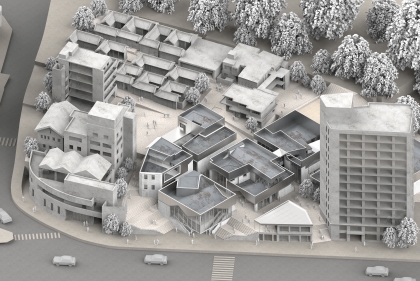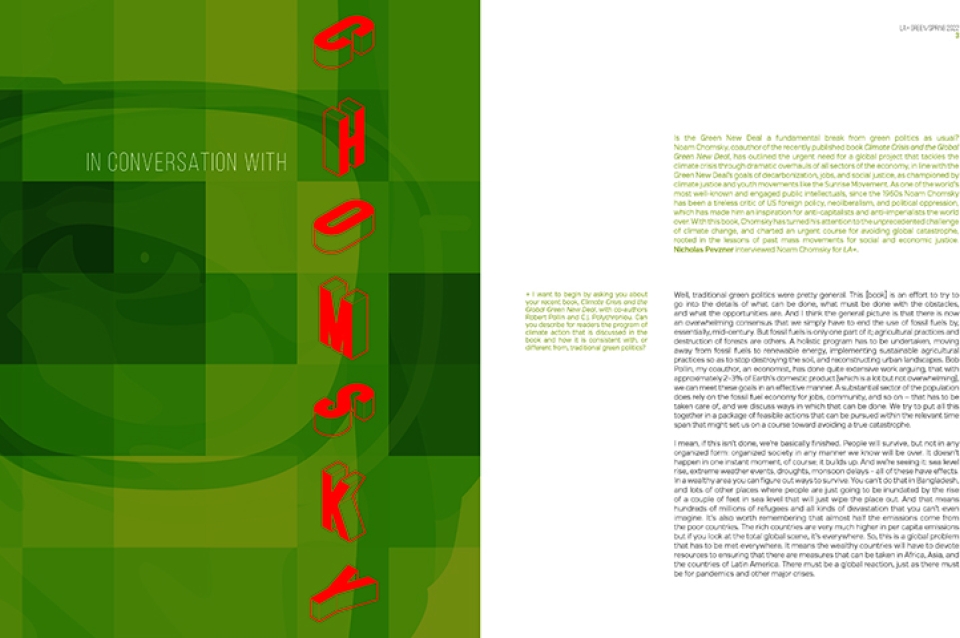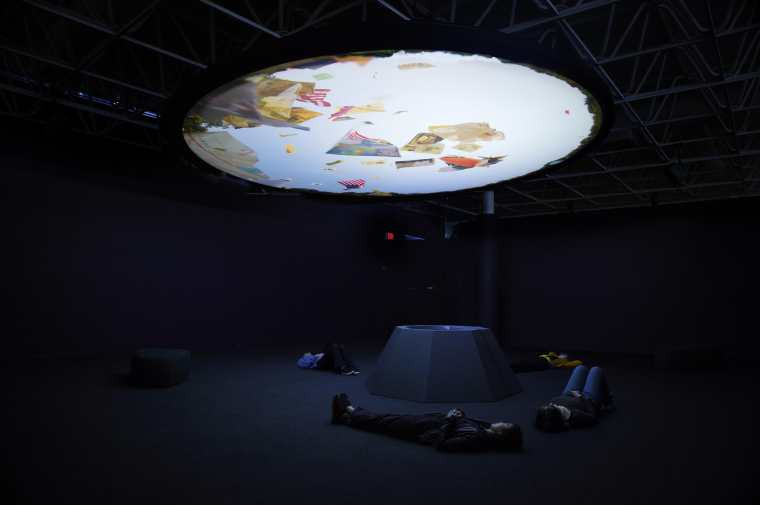April 5, 2022
Stuart Weitzman School of Design
102 Meyerson Hall
210 South 34th Street
Philadelphia, PA 19104
Get the latest Weitzman news in your Inbox
Media Contact
Michael Grant
mrgrant@design.upenn.edu
215.898.2539
This excerpt of “In Conversation with Chomsky” comes from the just-released LA+ GREEN, the latest issue of LA+, the interdisciplinary landscape architectural journal of the Weitzman School. In the interview, Nicholas Pevzner, assistant professor of landscape architecture, talks with Noam Chomsky, the doyen of international green socialism, about his new book, Climate Crisis and the Global Green New Deal (co-authored with Robert Pollin).
Nicholas Pevzner: In the book you focus a lot of attention on the injustices between the Global North and the Global South. But at the same time, there’s this understanding that low-income communities of color in the Global North also face disproportionate vulnerability—the whole environmental justice movement was predicated on giving voice to that. How do you think of these two nested and interacting forms of inequality? And what’s the role of a Green New Deal—whether global or country-specific—in countering these nested inequalities?
Noam Chomsky: This is a question that is particularly dramatic in the United States because of its history, its nature. The [original] New Deal in the United States is basically what’s called social democracy in Europe. The United States is a very strange country in many ways. It’s practically the only country in the world outside of totalitarian dictatorships where you can’t use the word socialist. In the United States it’s a curse word. Everywhere else in the world, it’s like saying I’m a Democrat. You know, it’s nothing—you don’t even talk about it. But you have to realize that this country has gone through decades of intense [anti-socialist] indoctrination. You can’t pretend it’s not there—it’s deeply embedded in the society. It’s what Gramsci called hegemonic common sense; it’s like the air you breathe, you can’t break out of it. We’ve seen the [January 6, 2021] riots in Washington—the coup attempt—which is a reflection of deep-seated problems in this country: the power of white supremacy, of racism, the destruction of rural communities with neoliberal deindustrialization, and the lack of a cushion of social justice institutions. In Europe you have many of the same phenomena, but there is a kind of background of support that maintains the society. The United States doesn’t have that. I mean, even the most elementary things like universal health care, which is everywhere, is considered too radical for Americans. And this is because of the enormous power of business, the weakness of labor, the destruction of unions, and the decisions of both political parties to abandon the working class. Democrats abandoned them in the 1970s, leaving it open for demagogues to take over. What you have is a traditional Christian, white (often white supremacist) minority feeling their status attacked, their prospects destroyed, even leading to depths of despair, an extreme phenomenon. I think what happened in Washington is another kind of manifestation of that—organized and incited by an extremely effective demagogue. So, we have a special problem in the United States.
As far as people of color suffering from the effects of global warming—it’s all over the place. Even simple things like housing. When Trump eliminated the regulations on pollution from industrial plants, who suffers from it? Not me. I live in the suburbs; I don’t live near a polluting plant. The poor people who can’t go anywhere else live there, people who are overwhelmingly Black, Puerto Rican, and so on. So their death rates go up; they’re the ones who suffer. In many other ways the same is true. A holistic approach is necessary—one that introduces effective social justice measures alongside the reconstruction of life, so that it’s oriented toward a meaningful, decent life.
We see this in all kinds of ways. Take the Yellow Vest movement in France. What happened is that Macron imposed taxes on the poor. In the name of environmental sanity they have to cut back on carbon emissions. So, let’s have a higher gas tax: who pays that? The people who are forced to drive long distances to work, not the people in Paris who can walk across the street from their elegant homes to their elegant offices. If you look closely at the Yellow Vests, they were not anti-environmental, they just were saying, “Don’t put it on our backs, okay?” If you’d come up with the same program, but oriented it toward people’s needs instead of formulated as a burden that they alone have to bear, I think it would have had a lot of support.
NP: In the book you contrast that example of the Yellow Vest movement against the counter-example of a mass mobilization that includes the working class in a much larger kind of global climate movement. Could you discuss the importance of this idea of mass mobilization for achieving the policies needed to avoid climate catastrophe?
NC: Well, the question is, who’s going to make the decisions? If the decisions are in the hands of concentrated private capital, they will make decisions that maximize private profit and power, control of market share, and control of the government. Not because they’re bad people, but because it’s built into the institution. If a CEO decides not to do that, he’s kicked out. So there must be an alternative source from which decisions are made, and it can only be the general public, the one part of the society that is by necessity committed to the public good, the common good. That’s mass mobilization. Organizing people so that they don’t just individually sit in front of their computers and send email messages to each other, saying, “Gee, this is a rotten situation,” but actually get together and do something about it. That’s how everything decent in society has been achieved.
I’m old enough to have vivid memories of the Great Depression, which was, from the economic point of view, much more serious than today. And what led to the breakout from the Depression—the New Deal—was mass, popular mobilization. A large part of it was centered in the labor movement. It had been crushed (pretty much like today) in the 1920s—mainly by Woodrow Wilson’s Red Scare. Unions were broken, but they began to revive, with the Congress of Industrial Organizations (CIO) organizing militant labor actions. They broke race barriers: black and white, working for a common aim. It got to the point of almost taking over factories, and at that point the rich began to take notice, the government was more or less sympathetic. And that was a breakthrough to important policies and programs that we still benefit from today (though there have been efforts to chip away at them for the last 40 years). Well, the same was true of the civil rights movement. There were individuals who were very heroic, did important things. But until it reached the stage of a real, largescale mass movement, nothing happened. There were ways of deflecting it; when you look through history, that’s always been the case.
I think it’s understood by a large portion of the population that addressing the climate crisis is a global problem. And, in fact, this is not a choice. There’s going to have to be. a rapid movement toward the elimination of fossil fuels, reconstruction of agriculture, rebuilding of cities, ending of habitat destruction. We simply don’t have a choice. What has to be brought home to consciousness, is that we are in a unique moment of history. These problems have never arisen before. If they’re not solved in this generation, we’re basically done for. It’s as simple as that. There are no alternatives to trying to deal with this expeditiously and effectively. And it can be done. The means are within our hands.
NP: Could you talk about the split between the labor and environmental movements, and what is needed in order to close that historic rift? Is there something about the history of labor in the United States that exacerbates this antagonism?
NC: Actually, the environmental movement started in the labor movement. This goes back to the early 1970s, before there was much of an active environmental movement, just the bare beginnings. But one of the major labor unions, the Union of Oil, Chemical and Atomic Workers (OCAW), led by Tony Mazzocchi, became the leading force of environmentalism. They’re the ones who pushed through workplace regulations, occupational safety and health regulations, and environmental regulations. And it’s in a way, understandable. These are people who are right at the forefront of pollution, working in the midst of the worst pollution in the oil and chemical industries. It’s affecting them.
Mazzocchi, a committed environmentalist, wanted to push on to the general environmental problems. It was beaten back the way such initiatives tend to be in the United States, but he went on to try to form a Labor Party, which would put together the needs of the labor movement—or a reconstituted, rebuilt labor movement—and the environmental movement. And their interests are in common. Take an oil worker in South Texas: he’s got a job, may even be well paid, but it’s a pretty rotten job. He would do much better working, using his skills, on renewable energy: better job, better pay, save his community, save his grandchildren—all of that fits together. It’s a labor issue, even more than for professionals, for example.
So yes, I think there’s a lot of possibility for a reconstituted, rebuilt, revitalized labor movement, once again at the forefront of environmental struggles. I think one of the great things that Bob Pollin is doing is working directly with unions. He has managed to establish contacts with some of the major unions to try to put together programs that will deal with the immediate problem of the transition to a new economy, which has to take place, and also designing that new economy so that it has plenty of good jobs, plenty of good work—much better than today—and leads to a better society.
NP: In the book you mention how in Canada the labor movement did not make the same decision as it did in the United States to forgo public health insurance. Can you tell us about that?
NC: Yes, it’s interesting to see how that worked. You go back to the 1950s when Canada didn’t have public health care—the effort to create national health care was, to a large extent, spearheaded by the labor movement. Now, it’s very striking that the same labor movement on the two sides of the border acted differently. In Canada, the United Auto Workers union (UAW) and others worked for a national health care system. In the United States, the same unions worked for good health programs for themselves. (In fact, it’s what President Obama condemned as “Cadillac systems.” Part of the reason he lost the working vote was because of attacking their health systems.) Now of course the UAW here in the United States sacrificed something. They made a deal with management, in which they handed over control of the workplace, and the management put it all in the hands of rich bankers in Chicago and New York. In return they got fairly decent welfare systems for themselves—not for the society. By the late 1970s, big capital called off the game. They said, “We’re taking over, period. It’s called neoliberalism.” The labor movement was left hanging on the vine. You make that kind of deal with business, it’s not because they’re nice guys. It’s because it’s good for them at that time. And in fact, that was recognized, but too late.
By 1978, the head of the UAW left a labor management conference set up by the Carter administration to adjudicate problems. He quit, and made a strong statement saying, “You’ve sold us out. We thought we had a bargain, and now you’re fighting a one-sided class war against the labor movement.” He discovered a little bit late that it’s always a one-sided class war if you decide not to take part. And the agreements of capital-labor mutual love, they collapsed as soon as capital said, “It’s not for us.” Then you move into the neoliberal period, and the mass robbery. Class collaboration may sound good, but it’s not good for the society. That’s a major reason why we don’t have public health care. The force that’s always been in the forefront of moving forward—the labor movement—just wasn’t pressing for it.
NP: You alluded to the way in which the city, the energy system, all of these major pieces of the built environment will need to be reconstructed. Designers often think of themselves as apolitical, and the design professions are not as steeped as many others in the vocabulary of political theory and political movements. What are your views on how designers should think about their role in the political spectrum, as both members of the professional class, as well as advocates for the public good?
NC: Designers are professionals who have special skills – they’re human beings who want a reasonable, decent society. They can put those professional skills to work to try to develop the kind of society that will be livable for them and for everyone else. I don’t think this is very profound. You don’t have to know any political theory. And in the case of landscape architects, it’s almost immediate: the society has to be redesigned. Radically redesigned. Everything from agriculture, to construction, to urban spaces, the nature of how enterprises are run, to where the energy is going to come from. I mean, all of these things have to be addressed. They’re real problems; a lot of which are serious. Take where I live in Tucson, Arizona, it’s right near a huge copper mine. Notice the contradiction. Copper mining is extremely destructive and polluting. On the other hand, if you don’t do it, you don’t have electrification, and you have to have electrification if you’re going to overcome the environmental crisis. These are real questions that have to be dealt with. Probably there are technical answers, and the people who have the technical knowledge and understanding are the ones who are going to have to work on providing those answers. That’s their duty and responsibility. Much the same is true of landscape architects. They’re the ones who have the privilege, the skill, the understanding to deal with serious technical problems in their field. Technical problems are not minor. They’re critical. You have to do things the right way or else you get into terrible trouble. You have the skill to do things the right way? Put it to use.


 Expand Image
Expand Image



